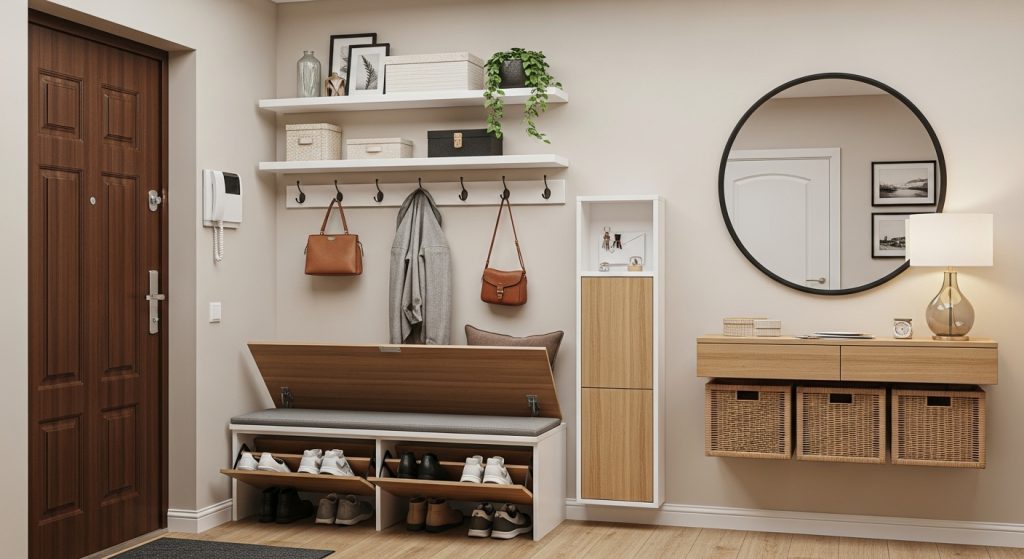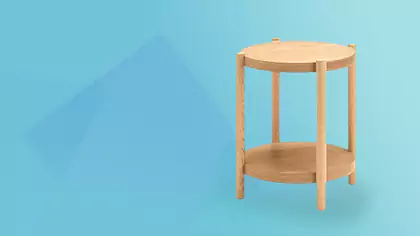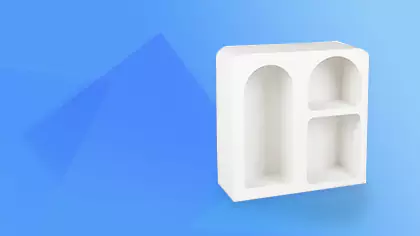These small entryway hacks to hide shoes neatly provide a definitive guide to conquering footwear clutter and creating a stylish, organized first impression, even in the most compact spaces. The entryway is your home’s greeting card, but in small homes and apartments, it often becomes an unavoidable drop zone for shoes, leading to visual chaos and tripping hazards. The solution lies in clever, space-saving strategies that prioritize concealed storage.

This professional guide explores innovative and practical ideas. It covers vertical solutions, multi-functional furniture, utilizing hidden nooks, and smart container usage. It will empower you to implement stylish and discreet storage, transforming your small entryway into a serene, functional, and welcoming threshold.
What is the Core Principle of Hiding Shoes in Small Entryways?
The core principle is maximizing storage efficiency while minimizing visual footprint and clutter. In a small entryway, every item on display contributes to the feeling of crowdedness. Therefore, hiding shoes becomes essential not just for tidiness but for creating an illusion of greater space. This involves using storage solutions that are either physically compact, multi-functional, or utilize otherwise wasted space, always prioritizing concealed compartments over open racks.
This approach focuses on creating a calm and orderly first impression. It recognizes that visible shoe collections, even if neat, can make a small space feel busy and less welcoming. By choosing clever storage that keeps footwear completely out of sight, you maintain clean lines and a serene atmosphere. This allows the entryway’s intentional design elements, however minimal, to shine. This philosophy aligns with effective shoe cabinet organization design, adapting it specifically for space constraints. The growing trend towards minimalist living emphasizes the value of decluttered, functional spaces.
Why is Hiding Shoes So Crucial in a Small Entryway?
Hiding shoes is crucial in a small entryway for several compelling reasons that impact both the functionality and the perceived quality of your home. It moves beyond simple tidiness; it is a strategic design choice that addresses the unique challenges of limited square footage.
How Does Shoe Clutter Visually Shrink a Small Space?
Shoe clutter visually shrinks a small space by creating multiple, low-level points of visual distraction. A pile of shoes by the door, or even shoes lined up on the floor, breaks up the clean lines of the entryway. This makes the floor area appear smaller and more chaotic. Our brains perceive cluttered spaces as being smaller and more stressful than organized ones. Hiding the shoes eliminates this visual noise, allowing the eye to perceive the full dimensions of the floor and walls, making the space feel instantly larger and calmer.
What First Impression Does a Shoe-Free Entryway Create?
A shoe-free entryway creates a first impression of order, calm, and intentionality. It suggests that the home is well-maintained and thoughtfully organized. Conversely, an entryway littered with shoes can signal disorganization and neglect, regardless of how stylish the rest of the home may be. As the first point of contact, the entryway sets the visitor’s expectation. Keeping shoes hidden contributes significantly to a positive and welcoming initial experience. This principle is key for anyone aiming for a high-end, curated home environment.
How Does Hiding Shoes Improve Functionality and Safety?
Hiding shoes improves functionality by keeping walkways clear. Shoes left on the floor are significant tripping hazards, especially in narrow or dimly lit entryways. Providing a designated, concealed storage spot ensures the path is always clear and safe for movement. It also makes cleaning the entryway floor much easier, as there are no obstacles to navigate around. This practical benefit is a major driver for implementing effective storage solutions.
Hack 1: How Can You Maximize Vertical Wall Space?
Maximizing vertical wall space is the number one strategy for small entryway hacks to hide shoes neatly. By utilizing the height of the wall, you can create significant storage capacity without consuming valuable, limited floor space. This “thinking upwards” approach is fundamental to small-space design.
Why Are Ultra-Slim Wall-Mounted Cabinets Ideal?
Ultra-slim wall-mounted cabinets are ideal because they provide significant shoe storage while consuming zero floor space. Their shallow depth allows them to fit flush against walls in narrow hallways, offering concealed storage and a clean, modern look that enhances the sense of spaciousness.
These cabinets often feature clever tilt-out mechanisms that store shoes vertically or at an angle, packing maximum capacity into a depth of just 6-10 inches. They present a sleek, unobtrusive facade when closed, perfectly aligning with a minimalist or modern aesthetic. Our guide to wall-mounted shoe cabinet ideas to save floor space showcases the variety available. Secure installation is crucial for safety.
Can Tall, Narrow Floor Cabinets Work Effectively?
Yes, tall, narrow floor cabinets can also be effective vertical solutions, especially if wall-mounting is not an option. Look for “shoe towers” or very slender cabinet designs that maximize height on a minimal footprint. These can often tuck neatly into a corner or beside the door. Choose designs with doors to keep the shoes hidden. Lighter colors or mirrored doors can help reduce the visual weight of a taller unit.
What About Utilizing Space Above Existing Furniture?
Consider adding shallow, wall-mounted storage above an existing entryway console table or bench. A closed cabinet or even simple floating shelves with attractive opaque storage boxes can provide extra shoe storage by utilizing the upper portion of the wall. Ensure the placement is high enough not to interfere with the use of the furniture below but still accessible.
Hack 2: How Can Multi-functional Furniture Conceal Shoes?
Multi-functional furniture is a small space superhero. Pieces that combine essential entryway functions (like seating or a surface) with integrated hidden shoe storage are incredibly efficient. They reduce the number of separate furniture items needed, saving space and creating a more cohesive look. Our guide to multifunctional entryway furniture ideas with storage explores these smart designs.
Why Are Storage Benches the Ultimate Entryway Solution?
Storage benches are often considered the ultimate entryway solution because they elegantly combine seating and concealed storage. They provide a practical spot to sit while putting on or taking off shoes, while the space underneath is utilized for hiding footwear.
- Lift-Top Benches: Offer a large, completely hidden compartment inside. Ideal for bulkier items or a larger number of pairs.
- Benches with Drawers: Provide organized, concealed storage. Look for deep drawers suitable for shoes.
- Benches with Cabinet Doors: Keep shoes completely out of sight behind solid doors. Choose a bench size and style that fits your entryway dimensions and decor.
How Can Storage Ottomans Provide Discreet Seating and Storage?
Storage ottomans offer another clever way to combine seating and hidden storage, particularly useful if your entryway opens directly into a living space. A stylish ottoman with a lift-off or hinged lid can hold several pairs of shoes inside while providing extra seating or a footrest. Choose durable, easy-to-clean upholstery suitable for an entryway. This solution is completely inconspicuous – guests would never guess it holds shoes.
Can Standard Furniture Be Adapted for Hidden Shoe Storage?
Yes, standard furniture pieces can sometimes be adapted. A Console table with a low shelf can become hidden storage by adding attractive, opaque baskets or bins underneath. A deeper drawer in an entryway cabinet could be repurposed specifically for shoes, perhaps with added dividers. This approach involves creatively assessing the hidden potential within your existing furniture.
Hack 3: How to Leverage Underutilized and Awkward Spaces?
Tiny entryways often have awkward nooks, crannies, or adjacent spaces that can be cleverly repurposed for hidden shoe storage. Thinking creatively about these “dead zones” can unlock valuable storage potential without taking up prime real estate. These are some of the most effective small entryway hacks to hide shoes neatly.
Why is Under-Bench or Under-Console Space Prime Real Estate?
The space underneath an open-leg console table or an entryway bench is prime real estate for hidden storage. Use decorative baskets, bins, or boxes that fit neatly into this space. Choose opaque containers to keep the shoes completely concealed. This strategy utilizes the space below eye level, keeping the main visual field clear while providing significant storage capacity. Ensure the containers complement your decor style (e.g., woven baskets for a farmhouse look, sleek boxes for modern).
How Can You Maximize Space Inside an Entry Closet?
If your entryway has even a small coat closet, maximize its shoe storage potential. Do not just toss shoes onto the closet floor.
- Add Low Shelves: Install simple shelves at the bottom specifically for shoes.
- Use Stackable Organizers: Clear plastic shoe boxes or stackable wire racks can create multiple tiers of storage on the floor or on existing shelves.
- Utilize the Door: Install an over-the-door organizer inside the closet for flatter shoes. Treating the entry closet as dedicated shoe territory frees up the main entryway space. This is a core strategy in how to organize shoes in small spaces without clutter.
What About Utilizing the Space Behind Doors?
The narrow space behind a door that opens against a wall is often completely overlooked. Ultra-slim wall-mounted racks or shallow shelves can sometimes be installed in this gap. When the door is open (which it often is in an entryway), the shoes are completely hidden from view. Measure carefully to ensure the storage unit doesn’t interfere with the door opening fully.
Can Stair Risers Be Converted into Drawers?
For homeowners willing to undertake a more involved renovation, the space inside stair risers (the vertical part of each step) can sometimes be converted into small, hidden drawers. These are perfect for storing individual pairs of flat shoes or children’s shoes. This is a highly custom and ingenious solution for maximizing every possible inch in a multi-level home. This requires professional carpentry skills.
Hack 4: How Can Containers and Baskets Provide Stylish Concealment?
Using attractive containers is a simple yet highly effective strategy for hiding shoes in plain sight or within open storage furniture. The right basket, bin, or box becomes a decorative element itself, while neatly concealing the footwear inside.
Why Choose Opaque Baskets and Bins?
Choose opaque baskets and bins (rather than open wire or clear plastic) when the goal is complete concealment. Materials like woven seagrass, jute, felt, canvas, or solid wood provide a visually solid exterior that hides the contents completely. Select containers that have lids for an even tidier appearance. Ensure the size and shape fit neatly into your chosen space (under a bench, on a shelf, etc.). The market for stylish storage containers is vast, offering options for every decor style.
How Can Vintage Trunks or Chests Double as Shoe Storage?
A vintage trunk or a beautiful wooden chest placed in the entryway serves multiple purposes. It acts as a character-filled decorative piece, provides a surface for placing items, and offers capacious hidden storage inside. Simply place shoes neatly within the trunk. Adding simple dividers or shoe organizers inside can help maintain order. This is a fantastic example of repurposing furniture into shoe cabinets.
What About Using Large Decorative Floor Baskets?
If space allows for a slightly larger footprint, a tall, decorative floor basket with a lid can serve as a stylish shoe bin near the door. Choose a basket with a beautiful weave or material that enhances your decor. This keeps frequently worn shoes easily accessible but contained and out of sight. Ensure the basket has a sturdy structure.
Hack 5: What Are Creative DIY Solutions for Hidden Storage?
DIY solutions offer the ultimate in customization and budget-friendliness. Creating your own hidden shoe storage allows you to tailor the design perfectly to your specific space and needs. These DIY practical shoe storage ideas often involve simple materials and clever construction.
How Can You Build a Simple Bench with Hidden Storage?
Building a simple storage bench is a popular DIY project. It can be constructed from basic lumber or plywood. Design a sturdy bench frame. Create a storage compartment underneath that can be accessed either via drawers, cabinet doors, or a lift-up seat. Plans and tutorials for various styles are widely available online. This allows you to create a high-quality, custom piece for a fraction of the retail cost.
What About Modifying an IKEA Kallax or Similar Cube Unit?
Cube storage units (like the IKEA Kallax) are highly adaptable for DIY shoe storage. You can:
- Add Doors: Attach simple doors (DIY or purchased inserts) to the front of some cubes to create concealed storage.
- Insert Baskets: Use attractive fabric or woven baskets that fit perfectly into the cubes.
- Create Dividers: Add simple diagonal dividers within a cube to store multiple pairs of smaller shoes vertically. These versatile units can be positioned horizontally to act as a bench or vertically as a tower.
How to Build a Slim Wall-Mounted Tilt-Out Cabinet?
For those with more advanced DIY skills, building your own slim, wall-mounted tilt-out shoe cabinet offers complete customization in size and finish. This project involves constructing a shallow cabinet box and creating the pivoting drawer mechanisms. It requires precise measurements and careful assembly. Following a detailed plan, perhaps adapted from the concepts in how to build a foldable shoe cabinet step by step, is essential. The result is a high-end, space-saving solution tailored perfectly to your wall.
How to Maintain a Neat and Hidden Shoe System?
Implementing a storage solution is only the first step. Maintaining its effectiveness requires consistent habits and periodic adjustments. A hidden system only works if shoes are actually put away inside it.
Regular decluttering remains crucial. Even with ample hidden storage, collections can grow. Purge unwanted shoes seasonally. Implement a strict “one pair in, one pair out” rule to prevent accumulation. Most importantly, establish a firm household habit: shoes get put away in their designated hidden spot immediately upon entering the home. This daily discipline is the absolute key to preventing entryway clutter from returning. Consistency is the cornerstone of all successful organization systems.
Conclusion
These small entryway hacks to hide shoes neatly demonstrate that a clutter-free and stylish first impression is achievable even in the most compact homes. By prioritizing vertical space, embracing multi-functional furniture, utilizing hidden nooks, employing stylish containers, and perhaps adding a touch of DIY creativity, you can effectively conceal your shoe collection. These clever hidden shoe storage ideas for apartments and small homes transform the entryway from a potential source of stress into a serene, organized, and welcoming space. The result is not just a tidier home, but a calmer state of mind from the moment you walk through the door.











